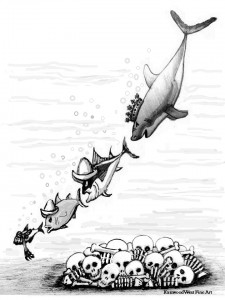Grudge Match
Posted in General on July 8th, 2010 by Eugene Finerman – 5 CommentsSpain-Netherlands: World Cup Finalists
JOHANNESBURG — The first World Cup in Africa appropriately presents something new: Spain or the Netherlands as a first-time champion.
This could be a revenge match for the Treaty of Westphalia. The last time the teams played, the match lasted 80 years and the Dutch won.
The source of the conflict was existential. The Spanish asserted their right to burn the Dutch alive, and the Dutch disagreed. Now, from a purely legal perspective, the Spanish were correct. Thanks to a skein of marriages, the King of Spain was named Hapsburg and he was the sovereign ruler of the Low Countries. And thanks to a Spanish upbringing, Philip II was a religious fanatic. When he inherited the crown in 1558, Philips did not regard the Netherlands as a prosperous, happy land that filled the royal coffers. No, he viewed it as a haven of heresy. You can’t quibble with Philip’s knowledge of demographics. Calvinism, with its tenets that money is God’s expression of congratulations, had appealed to the Dutch love of commerce. The Protestants now made up a majority of Philip’s Dutch subjects. And as their sovereign, Philip had the right to persecute them.
His most Catholic Majesty had hoped that an Inquisition would suffice. It had proved a success in Spain. In 1560, he appointed an archbishop as Prime Minister of the Netherlands and you can guess his primary purpose. However, the Inquisition–with its legal procedures, etiquette of torture, and theatrical executions–really was time-consuming and laborious. It worked well dealing with a minority with a suspicious reluctance toward pork; but the Inquisition simply couldn’t process all the Dutch Protestants who required trial and incineration. Nor were the Calvinists affable enough to baste themselves with oil and proceed to the nearest bonfire.
The cinders from the uncooperative victims were only inflaming the unrest in the Netherlands. Even the Dutch nobility, many of whom were Catholic, objected to the Inquisition and signed petitions in protest. The King only noted the names, not their grievances. He did agree, however, the Inquisition had failed to crush the heresy. In 1567 Philip named the Duke of Alva to be the governor of the Netherlands, and the Duke brought with him 12,000 soldiers. Upon the Duke’s arrival in Brussels, he was met by a delegation of the leading nobles of the Netherlands. They were all Catholic but many of them were moderates who had pled for an end to the Inquisition. The Duke demonstrated his idea of tolerance by having the moderates beheaded. That gave the Protestants a clear impression of the Duke’s attitude toward them.
The Duke of Alva knew how to start a war but, even with an army of 12,000, he didn’t know how to end it. His troops might sack and massacre Dutch towns, but only the dead were pacified. The Netherlands were in revolt. The Spanish were so unpopular that they could not even count on Catholic support, and the Calvinists were fighting for their survival. Alva needed more men, but Philip was preoccupied with fighting the Ottomans. The Dutch, however, did have allies. The Protestant princes of Northern Germany provided assistance, subsidizing armies of mercenaries for the Dutch leader William of Orange. And despite Queen Elizabeth’s charming and straight-faced assertions of neutrality, England was providing haven for Dutch privateers.
In 1573, Philip dismissed Alva, hoping to find a better general. Three governors and five years later, Philip found him: his own nephew, the Duke of Parma. Through Parma’s efforts, the Spanish regained control of the Southern provinces of the Netherlands; it was to become the country we know as Belgium. But the northern provinces successfully resisted the Spanish. By 1586, the English had abandoned all pretence at neutrality. An English army was fighting in the Netherlands; even if it only lost battles, it still was a drain on Parma’s resources. The exasperated Philip II concluded that conquering England would also break the Dutch resistance. He assembled an Armada…but you know that story. Let’s just say that the Duke of Parma never got to London or Amsterdam.
Having successfully defended themselves, the Northern Provinces simply declared themselves a Republic in 1588. So what if the Spanish wouldn’t recognize it? The Dutch state existed and was in business. The war tapered down to token skirmishes and by 1609 the Spanish agreed to a 12 year truce. In 1621 the war officially resumed, and there was a major battle in 1624–which the Spanish won! The Spanish gained a suitable subject for a Velazquez painting, and that was about it. Finally, in 1648, as part of the Treaty of Westphalia the Spanish conceded the independence of the Dutch.
And the outcome of the World Cup match probably won’t change that.
